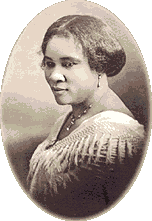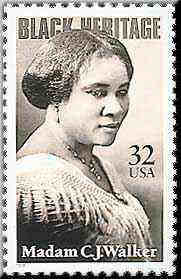 1867
Sarah Breedlove (Madam C. J. Walker),
on a Delta, Louisiana, plantation 1867
Sarah Breedlove (Madam C. J. Walker),
on a Delta, Louisiana, plantationThis daughter of former slaves transformed herself from an uneducated farm laborer and laundress into of the twentieth century's most successful, self-made women entrepreneur. Orphaned at age seven, she often said, "I got my start by giving myself a start. “ She and her older sister, Louvenia, survived by working in the cotton fields of Delta and nearby Vicksburg, Mississippi. At 14, she married Moses McWilliams to escape abuse from her cruel brother-in-law, Jesse Powell. Her only daughter, Lelia (later known as A'Lelia Walker) was born on 06 June 1885. When her husband died two years later, she moved to St. Louis to join her four brothers who had established themselves as barbers. Working for as little as $1.50 a day, she managed to save enough money to educate her daughter. Friendships with other black women who were members of St. Paul A.M.E. Church and the National Association of Colored Women exposed her to a new way of viewing the world. During the 1890s, Sarah began to suffer from a scalp ailment that caused her to lose most of her hair. She experimented with many homemade remedies and store-bought products, including those made by Annie Malone, another black woman entrepreneur. In 1905 Sarah moved to Denver as a sales agent for Malone, then married her third husband, Charles Joseph Walker, a St. Louis newspaperman.  After changing her name to “Madam” C. J. Walker, she founded
her own business and began selling Madam Walker's Wonderful Hair Grower,
a scalp conditioning and healing formula, which she claimed had been
revealed to her in a dream. Madam Walker, by the way, did NOT invent
the straightening comb, though many people incorrectly believe that
to be true. To promote her products, the new “Madam C.J. Walker”
traveled for a year and a half on a dizzying crusade throughout the
heavily black South and Southeast, selling her products door to door,
demonstrating her scalp treatments in churches and lodges, and devising
sales and marketing strategies. In 1908, she temporarily moved her
base to Pittsburgh where she opened Lelia College to train Walker
“hair culturists.”
After changing her name to “Madam” C. J. Walker, she founded
her own business and began selling Madam Walker's Wonderful Hair Grower,
a scalp conditioning and healing formula, which she claimed had been
revealed to her in a dream. Madam Walker, by the way, did NOT invent
the straightening comb, though many people incorrectly believe that
to be true. To promote her products, the new “Madam C.J. Walker”
traveled for a year and a half on a dizzying crusade throughout the
heavily black South and Southeast, selling her products door to door,
demonstrating her scalp treatments in churches and lodges, and devising
sales and marketing strategies. In 1908, she temporarily moved her
base to Pittsburgh where she opened Lelia College to train Walker
“hair culturists.” By early 1910, she had settled in Indianapolis, then the nation's largest inland manufacturing center, where she built a factory, hair and manicure salon and another training school. Less than a year after her arrival, Walker grabbed national headlines in the black press when she contributed $1000 to the building fund of the "colored" YMCA in Indianapolis. In 1913, while Walker traveled to Central America and the Caribbean to expand her business, her daughter A'Lelia, moved into a fabulous new Harlem townhouse and Walker Salon, designed by black architect, Vertner Tandy. “There is nothing to equal it," she wrote to her attorney, F.B. Ransom. “Not even on Fifth Avenue. “ Courtesy: Museum of the City of New York Walker herself moved to New York in 1916, leaving the day-to-day operations of the Madam C. J. Walker Manufacturing Company in Indianapolis to Ransom and Alice Kelly, her factory forelady and a former school teacher. She continued to oversee the business and to run the New York office. Once in Harlem, she quickly became involved in Harlem's social and political life, taking special interest in the NAACP's anti-lynching movement to which she contributed $5000. In July 1917, when a white mob murdered more than three dozen blacks in East St. Louis, Illinois, Walker joined a group of Harlem leaders who visited the White House to present a petition favoring federal anti-lynching legislation.  As her business continued to grow, Walker organized her agents into
local and state clubs. Her Madam C. J. Walker Hair Culturists Union
of America convention in Philadelphia in 1917 must have been one of
the first national meetings of businesswomen in the country. Walker
used the gathering not only to reward her agents for their business
success, but to encourage their political activism as well. “This
is the greatest country under the sun," she told them. “But we
must not let our love of country, our patriotic loyalty cause us to
abate one whit in our protest against wrong and injustice. We should
protest until the American sense of justice is so aroused that such
affairs as the East St. Louis riot be forever impossible. “
As her business continued to grow, Walker organized her agents into
local and state clubs. Her Madam C. J. Walker Hair Culturists Union
of America convention in Philadelphia in 1917 must have been one of
the first national meetings of businesswomen in the country. Walker
used the gathering not only to reward her agents for their business
success, but to encourage their political activism as well. “This
is the greatest country under the sun," she told them. “But we
must not let our love of country, our patriotic loyalty cause us to
abate one whit in our protest against wrong and injustice. We should
protest until the American sense of justice is so aroused that such
affairs as the East St. Louis riot be forever impossible. “ By the time Madam Walker died at her estate, Villa Lewaro, in Irvington-on-Hudson, New York, she had helped create the role of the 20th Century, self-made American businesswoman; established herself as a pioneer of the modern black hair-care and cosmetics industry; and set standards in the African-American community for corporate and community giving. Tenacity and perseverance, faith in herself and in God, quality products and "honest business dealings" were the elements and strategies she prescribed for aspiring entrepreneurs who requested the secret to her rags-to-riches ascent. “There is no royal flower-strewn path to success," she once commented. “And if there is, I have not found it for if I have accomplished anything in life it is because I have been willing to work hard. “ On January 28, 1998 the United States Postal Service issued the Madam C. J. Walker Commemorative stamp [<], the 21st in the Black Heritage Series, at a first-day-of-issue ceremony at the Madame Walker Theatre Center in Indianapolis. --// http://www.madamcjwalker.com/ |
1858 Andrea Tavernier, Italian artist who died on 15 November 1932.
1841 Handley C.G. Moule, Anglican theologian. He succeeded B.F. Westcott in 1901 as Bishop of Durham. A profound scholar, he could nevertheless speak and write for ordinary people, and published commentaries on nearly all of Paul's letters in the New Testament.
1834 The Hansom Cab is patented by Joseph Hansom. -- Dépôt du brevet d'un nouveau type de cabriolet, le "Hansom Cab". Cette invention de l'architecte nommé Joseph Hansom, fut l'un des plus grands succès du monde. En effet, cette voiture à cheval et à deux roues sera construite à des millions d'exemplaires au XIX ème siècle.
1823 A Visit from St. Nicholas, poem now attributed to Clement C. Moore (" 'Twas the night before Christmas...") is published in The Troy Sentinel (Troy NY). [research on early editions putting in doubt the Moore authorship of the 1823 version]
1812 Samuel Smiles Scotland, a writer who was all Smiles. SMILES ONLINE: Character -- Industrial Biography: Iron-Workers and Tool-Makers -- Jasmin: Barber, Poet, Philanthropist -- The Life of Thomas Telford, Civil Engineer, with an Introductory History of Roads and Travelling in Great Britain -- Men of Invention and Industry -- Self-Help: With Illustrations of Conduct and Perseverance
1805 Joseph Smith Jr Sharon Vt, would found Mormon church
1804 Charles-Augustin de Sainte-Beuve France, SAINTE-BEUVE ONLINE: Port-Royal. tome 1 tome 2 tome 3 tome 4 tome 5 -- Les cahiers -- Tableau de la poésie française au XVIe siècle. Tome premier Tome second -- La chaumière indienne
1790 Jean-François Champollion. In 1822 he successfully decoded the hieroglyphics of the Rosetta Stone (uncovered in 1799), and is recognized today as the founder of modern Egyptology.
1777 Alexander I Tsar of Russia (1801-25)
1732 Sir Richard Arkwright inventor (spinning frame).
1727 Pieter Jan van Liender, Dutch artist who died on 26 November 1779.
1648 Robert Barclay, Scottish Quaker theologian. He published his most famous work, An Apology for the True Christian Divinity, in 1676, making him the most prominent theologian in the early Quaker Church.
1597 Martin Opitz Germany, poet "Father of Modern German Poetry"